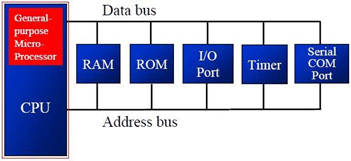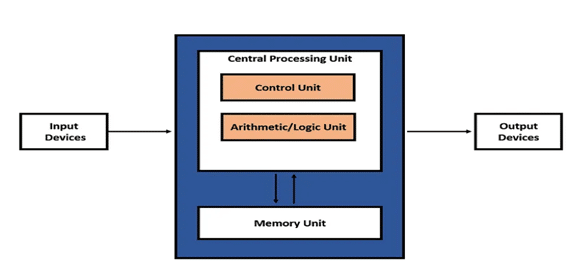Imagine a world without the numerous machines that automate our lives. No smartphones, no automobiles, and no appliances. It’s a universe that is difficult to understand in today’s technologically advanced civilization. Many of these machines are powered by a silent powerhouse known as an Embedded System.
Embedded systems are primarily computers that have been developed to do a specific task. They are often smaller, more energy-efficient, and more durable than general-purpose computers. They can be found in a wide range of devices, including everyday household products and crucial industrial equipment.
What is an Embedded System?
The phrase “embedded” refers to something that has been integrated into a bigger entity. An embedded system can be defined as a computer hardware system that includes embedded software. It may act as a standalone system or as part of a larger one.
Embedded systems provide several advantages, including precise control, compact size, reduced unit and development costs, increased flexibility, and excellent reliability.
These benefits help to enhance the entire system or device by:
- Improving performance
- Adding new features and capabilities
- Reducing costs and increasing reliability
Due to these advantages, billions of microcontrollers are supplied each year for use in embedded systems in a wide range of products. In basic terms, an embedded system is a microcontroller or microprocessor-based system created for a specific purpose. For example, a fire alarm is an embedded system that detects just smoke.
Characteristics of Embedded Systems
The primary trait of embedded systems is task-specific design. They frequently exhibit the following additional traits:
- Embedded systems are designed to perform certain tasks.
- They include hardware, software, and firmware.
- Frequently embedded in bigger systems to provide specialized functions.
- It might be microprocessor or microcontroller based.
- Often utilize ASIC or FPGA SoCs.
- Frequently used in IoT devices for real-time sensing and computing.
- Vary in complexity, influencing software, firmware, and hardware requirements.
- Must work under time limitations to keep the system functional.
Key Components of an Embedded System
- Sensor: Collects physical measurements and turns them into electrical impulses that may be analyzed or stored.
- A-D Converter: The A-D Converter converts the sensor’s analog signals into digital layout.
- Processor & ASICs: Process data and store it in memory.
- D-A Converter: The D-A Converter converts processed digital data back into analog form.
- Actuator: The actuator compares the output of the D-A converter to the predicted output and provides the final result.

Core Elements of Embedded Systems
Embedded systems consist of two primary components:
- Embedded System Hardware: An embedded system, like any other electronic system, requires a physical platform to function. Typically, this hardware is built around a microprocessor or microcontroller and contains memory, input/output (I/O) interfaces, user interfaces, and displays.
- Embedded System Software: This software is developed to do certain tasks. It is often written in a high-level language and then compiled into machine code, which is stored in non-volatile memory on the hardware. The image below depicts the basic structure of an embedded system.
Embedded System Hardware: Microcontroller vs Microprocessor
When designing embedded systems, engineers can choose between microcontrollers and microprocessors:
- Microcontroller-based systems: A microcontroller combines a central processing unit (CPU), memory, and peripherals, eliminating the need for extra components. Microcontroller-based systems are increasingly being used in embedded applications due to its simplicity and lack of external components. The basic block diagram is given below:
- Microprocessor-based systems: Microprocessor-based systems, on the other hand, just have the CPU and require additional components such as memory and peripherals to be added. Although this increases complexity, it also provides greater flexibility in bigger embedded systems.
For a more in-depth look at microcontrollers, a vital component of many embedded systems, you can refer to this insightful article on Microcontroller. The blog discusses the fundamentals of microcontrollers, such as their architecture, operating principles, and applications in diverse devices. Whether you’re new to microcontrollers or want to brush up on your expertise, this book offers a thorough overview that complements your understanding of embedded systems.
Embedded System Software:
Software is an important component of embedded systems, and there are several approaches to write it:
- Machine Code: Machine code is the lowest level programming language, consisting of fundamental hexadecimal instructions. Although it is rarely utilized today, it has direct control over the processor’s functions.
- Programming language: Writing machine code is time-consuming and error-prone, hence high-level programming languages such as C and C++ are commonly utilized. These are simpler to understand, manage, and debug.
Embedded System Architecture
Embedded systems use two main architectures:
Von Neumann Architecture:
John von Neumann proposed this architecture, which employs a single data bus for both instructions and data. This signifies that the CPU cannot fetch an instruction while also performing a data operation. Although simple, modern computing rates far outpace memory access times, necessitating the use of cache memory.
In the figure, there are three key facts in the Von Neumann-based computer
- A Von Neumann-based computer has a single processor.
- The instructions and data are in the same memory.
- The fetch-decode-execute cycle is employed to run the program.
Von-Naumann architecture consists of three key components.
- Central Processing Unit.
- Memory.
- Input/output devices.
Harvard Architecture:
In this architecture, instructions and data are stored on distinct storage and signal buses, allowing for simultaneous access to both. This increases efficiency, particularly in embedded systems.

Features of Harvard Architecture:
- Separate Memory Spaces: Separate locations for instructions and data enable simultaneous access, increasing speed.
- Fixed Instruction Length: Simplifies fetching and accelerates processing.
- Parallel Access: Parallel access enables parallel instruction and data processing.
- Efficient Memory Usage: Independent optimization improves efficiency.
- Ideal for embedded systems: Provides rapid access, which is critical for real-time applications.
- Limited Flexibility: Separation limits runtime instruction modification.
Harvard Architecture Vs von Neumann Architecture:
| Feature | Von Neumann Architecture | Harvard Architecture |
| Memory Structure | Instructions and data are stored in separate memory. | Instructions and data are stored in a single, unified memory |
| Data and Instruction Buses | Separate buses for instructions and data. | A single bus that handles both instructions and data |
| Simultaneous Access | Can access both instructions and data simultaneously. | Cannot acquire instructions and access data simultaneously. |
| Speed | Parallelism in instruction and data access allows for faster performance. | Slower since instructions and data share the same bus. |
| Complexity | More complex because of independent memory and buses. | Simpler having a single memory and bus structure. |
| Cost | Typically, greater due to separate hardware for memory. | Generally lower due to shared memory and buses. |
| Applications | Used in specialized systems such as DSPs and microcontrollers. | Typical in general-purpose computers. |
| Memory Usage | Programs and data are saved separately. | Programs and data use the same memory. |
Types of Embedded Systems:
Embedded system types vary based on their specific functions. These include:
- Mobile embedded systems are portable devices like digital cameras, smartphones, and laptop computers.
- Networked embedded systems use a network to communicate with other systems, such as home security or point-of-sale systems.
- Standalone embedded systems such as calculators or MP3 players, operate independently of a host system.
- Real-time embedded systems which produce output in a defined time period, are used extensively in the medical, industrial, and military sectors.
Embedded systems can also be classified based on their performance needs. These include:
- Small-Scale Embedded systems typically rely on a simple 8-bit microcontroller.
- Medium-Scale Embedded systems often utilize a more powerful 16-32-bit microcontroller and may connect multiple microcontrollers together.
- Advanced Embedded Systems frequently employ intricate algorithms, leading to software and hardware complexities. These systems may require sophisticated software, a flexible processor, and a programmable logic array.
Peripheral Devices in Embedded Systems:
Embedded systems communicate with the outside world through their peripherals, which include the following:
- Serial Communication Interfaces (SCIs) include RS-232, RS-422, and RS-485.
- Synchronous serial communication interfaces, such as I2C, SPI, SSC, and ESSI
- Universal Serial Bus (USB
- Multimedia Cards (SD Cards, Compact Flash, etc.
- Ethernet, LonWorks, and other network types.
- Field buses include CAN-Bus, LIN-Bus, and PROFIBUS.
- Timer types include PLL(s), Capture/Compare, and Time Processing Units.
- Discrete IO, often known as General Purpose Input/Output (GPIO), includes analog to digital and digital to analog converters (ADC/DAC).
- Debugging such as JTAG, ISP, ICSP, BDM, BITP, and DP9 ports
Also Check: How Embedded Systems and Sensors Work Together?
Advantages of Embedded Systems
- Efficiency: Efficiency is optimized for certain workloads, resulting in faster performance and lower power usage.
- Cost-Effective: Lower manufacturing costs due to simpler hardware and reduced component requirements.
- Compact Size: A smaller physical size enables integration into a variety of devices and environments.
- Dependability: Designed for specific functions, resulting in excellent dependability and stability.
- Real-Time Operation: The ability to process data in real time is required for crucial applications such as medical devices and automotive systems.
Disadvantages of Embedded Systems
- Limited Flexibility: Once designed, upgrading functionality might be difficult and expensive.
- Complex Development: Complex development necessitates specific knowledge and skills in hardware and software design.
- Dependence on Hardware: Performance is frequently linked to specific hardware combinations, which limits updates.
- Long Development Time: Because of the design and testing requirements, developing an embedded system can be time-consuming.
- Debugging challenges: Debugging embedded systems can be more difficult than debugging general-purpose computers.
Applications of Embedded Systems
- Consumer Electronics: Consumer electronics include smartphones, smart televisions, and digital cameras.
- Automotive: Engine control units, antilock brake systems, and infotainment systems are examples of automotive components.
- Industrial Automation: Industrial automation includes robotics, process control, and monitoring systems.
- Medical Devices: Medical devices include pacemakers, imaging systems, and patient monitoring equipment.
- Home Appliances: Home appliances include washing machines, microwaves, and smart thermostats.
Also Check: Innovative DIY Embedded System Projects Ideas
FAQs About Embedded Systems:
What is an embedded system?
- An embedded system is a specialized computing system that is intended to execute certain functions within a larger system.
How do embedded systems differ from general-purpose computers?
- Unlike general-purpose computers, embedded systems are designed to perform specific tasks, often with limited resources and capability.
What programming languages are commonly used for embedded systems?
- Common languages include C, C++, and assembly language, which are often used for their efficiency and hardware control.
Are embedded systems always standalone?
- Embedded systems can be standalone or part of larger systems, depending on their design and functionality.
What industries utilize embedded systems?
- Consumer electronics, automotive, healthcare, and industrial automation are all industries that make extensive use of embedded systems
Santoshi Pharate
A tech-savvy content creator who breaks down complex electronics and embedded systems into simple, relatable concepts for curious minds









